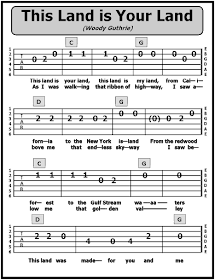NEW
WHAT CHILD IS THIS?
Here is a beautiful Christmas song about the birth of Christ in a minor key. Its tune is adapted from the old folk tune "Greensleeves." I have always loved playing "Greensleeves" as an instrumental tune, but this is also a wonderful song to sing at this special time of year.
A song "tag" is a short phrase that is "tagged" to the end of a song; often it is just the last couple of bars or last line of the song repeated. Here is a TAG line for the ending-- it is the last line with a twist-- complete with an alternate arpeggio in place of the two notes at the END.
WHITE CHRISTMAS
Here is the beautiful song "White Christmas" by Irving Berlin, made famous by Bing Crosby in the film of the same name.
A few guitar notes: (this also applies to other songs, including the one above)
- This song is arranged in the "Key of D"-- this is a new key for some of us, but it involves many familiar chords, with only a few "new" ones (see below).
- When a chord is shown in --(parentheses)-- this is meant to indicate an optional chord. Actually, these ARE part of the song, but as a Beginner Guitarist, it is possible to play with or without these particular chords.
- I have included the "beat" or rhythm under each line of the song. This will probably help you play as you follow the individual beats in the song.
There are a couple of new or different chords in this song. Both of them fall under that category of "optional" chords. But here they are--- they are a bit more difficult than most of the chords we've played. But they are still playable.
If you are a beginner, feel free to skip over these. If you are a serious or experienced player, you will want to challenge yourself to TRY to learn them.
The diminished chords are a four-finger chord which also has an unusual characteristic. It is one of the few chords which has equal intervals between notes. This causes it to be moveable. Every three frets, the notes in the diminished chord realign or "inverted" and therefore, the chord name changes, based on the Root note.
The G Minor here is an abbreviated version of a full Barre chord, based on the Emin chord. The optional bass note CAN be played with the thumb, while the index finger "barres" the three strings. Theoretically, these three notes can be played with three different fingers (similar to how some players fret the "A" chord), but this mini--barre is much easier, once you fight through and get comfortable with it.






































.jpg)
.jpg)